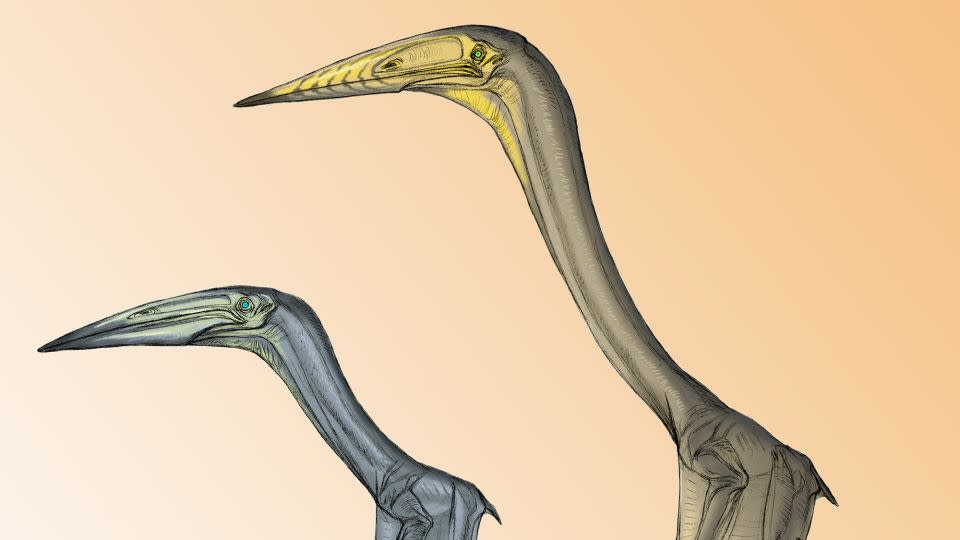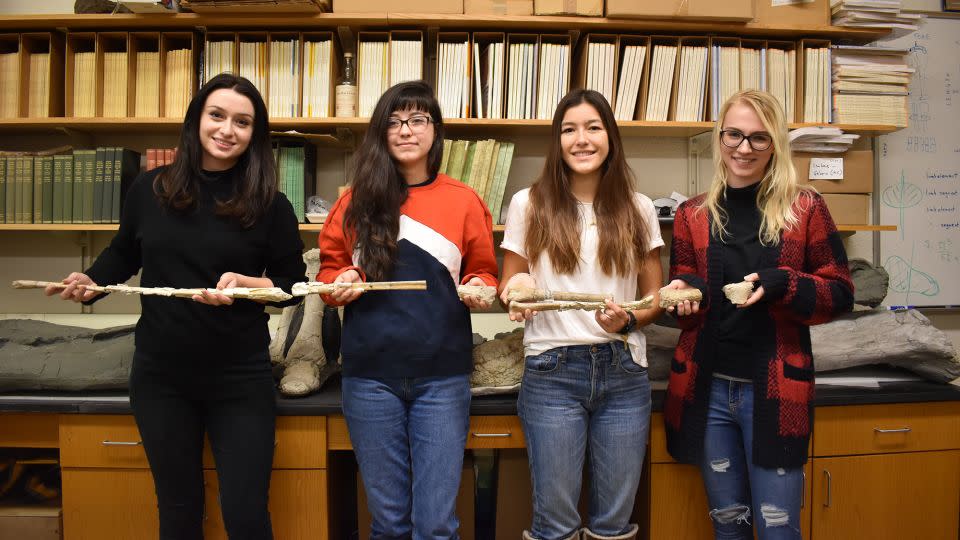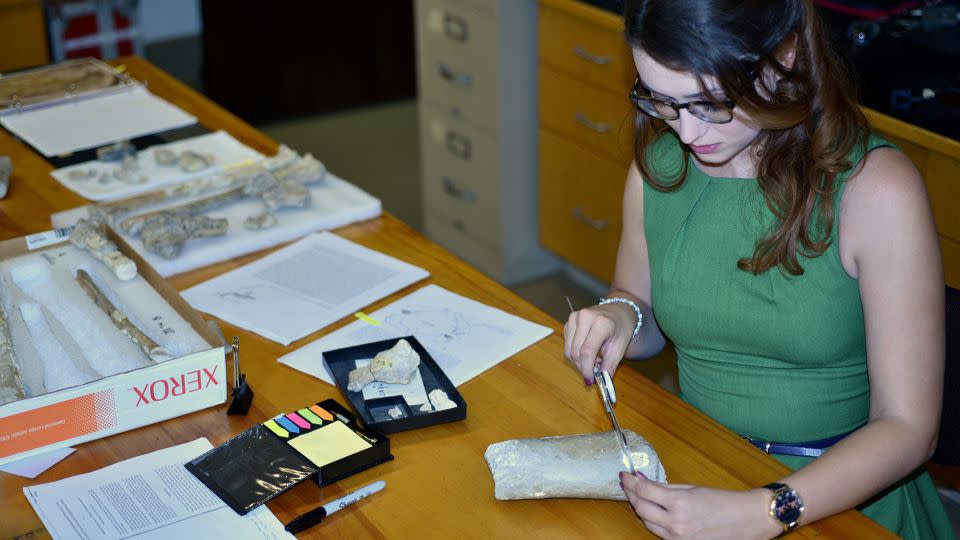Sign up for CNN’s Wonder Theory science newsletter. Explore the universe with news about fascinating discoveries, scientific developments and more.
Well-preserved fossils of large, ancient reptiles called pterosaurs have shown that some species flew by flapping their wings, while others glided like vultures, a new study finds.
Pterosaurs ruled the skies during the time of the dinosaurs, and suffered the same deadly fate 66 million years ago after an asteroid impact caused a mass extinction. Some of the largest pterosaur species were behemoths that grew to the size of small airplanes and reached heights comparable to giraffes, leading researchers to question whether pterosaurs could fly at all.
The newly discovered fossils reveal 3D structures in the delicate wing bones, which are typically found as flat pancakes in rock layers.
CT scans of the fossils provided a rare glimpse into the wing bones of two species of pterosaurs, including one that is new to science.
The results of the study, published Friday in the Journal of Vertebrate Paleontology, shed light on a remarkable and unexpected discovery: Not only could giant pterosaurs fly, but different species employed different flight techniques.
Intact fossils offer a window into the past
The fossils date to 66 to 72 million years ago, in the late Cretaceous period. The team initially found the specimens in 2007 at two sites in the north and south of what is now Jordan, buried in sediments from an ancient landmass called Afro-Arabia, which once included Africa and the Arabian Peninsula.
Once the research team realized that the hollow bones still contained their original structure, they wanted to analyze them using high-resolution CT scans, said lead researcher Dr. Kierstin Rosenbach, a paleontologist and researcher in the department of earth and environmental sciences at the University of Michigan in Ann Arbor.
Some of the fossils belonged to a giant pterosaur known as Arambourgiania philadelphiae, providing the first glimpse of its bone structure and confirming that it had a wingspan of 32.8 feet (10 meters). The team noted a series of ridges spiraling up and down its hollow humerus.
The remaining fossils belonged to a pterosaur new to science, called Inabtanin alarabia. It was named after the large grape-colored hill, Tal Inab, where it was unearthed. The name combines the Arabic words “inab,” for grape, and “tanin,” for dragon, while “Alarabia” refers to the Arabian Peninsula.
Inabtanin alarabia is one of the most complete pterosaur fossils ever found in the region, the researchers said. The reptile was smaller than Arambourgiania with a wingspan of 16.4 feet (5 meters).

When the researchers scanned the flight bones, they realized they were looking at a completely different structure than that of Arambourgiania.
The flight bones for Inabtanin included an internal structure of struts, or reinforcing rods, that helped them fly. These resemble those in the wing bones of modern birds that flap their wings to fly, Rosenbach said.
In contrast, the spiral ridges in the wing bones of Arambourgiania resembled the inner surfaces of the wing bones of vultures, which are thought to withstand the forces associated with gliding.
“The ridges found at Inabtanin were cool to see, but not unusual,” Rosenbach said in a statement. “The ridges at Arambourgiania were completely unexpected. We didn’t know what we were seeing at first.”
A variety of pterosaur flights
The largest flying modern bird is the Andean condor, which has a wingspan of 9 feet (about 2.8 meters). But pterosaurs had enormous wingspans that could reach 16.4 to 39.3 feet (5 to 12 meters).
“They represent the largest animals with the ability to fly,” Rosenbach said of the extinct reptiles.
The discovery that pterosaurs adapted different flight techniques is exciting because it provides insight into the behavior and lifestyle of these ancient reptiles, the researchers said.
“I think they would look noticeably different if we could see them flying side by side,” Rosenbach said. “Inabtanin would have flapped its wings, like modern birds, but Arambourgiania would more likely have glided with some wing flapping, like a vulture or a pelagic seabird.”
The fossils didn’t provide insight into how the pterosaurs took off from the ground, but the team is using the findings to determine how these different flight styles evolved.


“The variation in internal structure likely reflects the bone’s response to mechanical forces exerted on pterosaur wings,” said study co-author Jeff Wilson Mantilla, curator and professor at the University of Michigan Museum of Paleontology.
The researchers can’t say for sure which style came first, though among birds and bats, flapping is the most common, Rosenbach said. And even birds that soar or glide need some flapping to get airborne and stay in flight.
According to the authors, the method of flight likely evolved due to a combination of factors, including the environment the pterosaurs lived in, their body shape and size, and the way they hunted prey.
The scientists found both fossils in areas that were once a large, shallow sea. According to Rosenbach, it is possible that the two species behaved differently to find food in the same environment.
“This leads me to conclude that flapping flight is the default condition, and that gliding behavior might have evolved later if it were advantageous to the pterosaur population in a specific environment; in this case, the open ocean,” she said.
A changing view of the old flight
Pterosaurs’ wing bones had to withstand the stresses of flight while remaining lightweight. To do so, the hollow bones have several reinforcement structures in their bone walls, says Michael Benton, a professor of vertebrate paleontology at the University of Bristol in the United Kingdom.
“This is a beautiful study of the vertebral structure of two large pterosaurs, one big and one enormous,” said Benton, who was not involved in the research. “It has always been a mystery how pterosaurs could be light enough yet strong enough to fly, especially the many that were much larger than any known bird. This paper helps provide the answer.”


The study authors believe their findings provide new evidence for the ongoing debate among paleontologists over whether the largest pterosaurs could fly.
“The internal bone structure of these fossils suggests that they experienced the mechanical forces associated with flight,” Rosenbach said. “We can view these findings as one piece in the growing evidence that large pterosaurs retained the ability to fly at extremely large body sizes.”
The research team is eager to look at more scans of pterosaur bones and determine how the newly discovered pterosaur Inabtanin compares to the rest of the ancient reptiles.
“There is mounting evidence that pterosaurs were more diverse as they approached the great Cretaceous-Paleogene mass extinction than we previously thought,” Rosenbach said via email, referring to the mass extinction of dinosaurs and most life on Earth. “This indicates that the extinction was catastrophic as opposed to a slow process of extinction for large reptiles.”
For more CNN news and newsletters, create an account at CNN.com